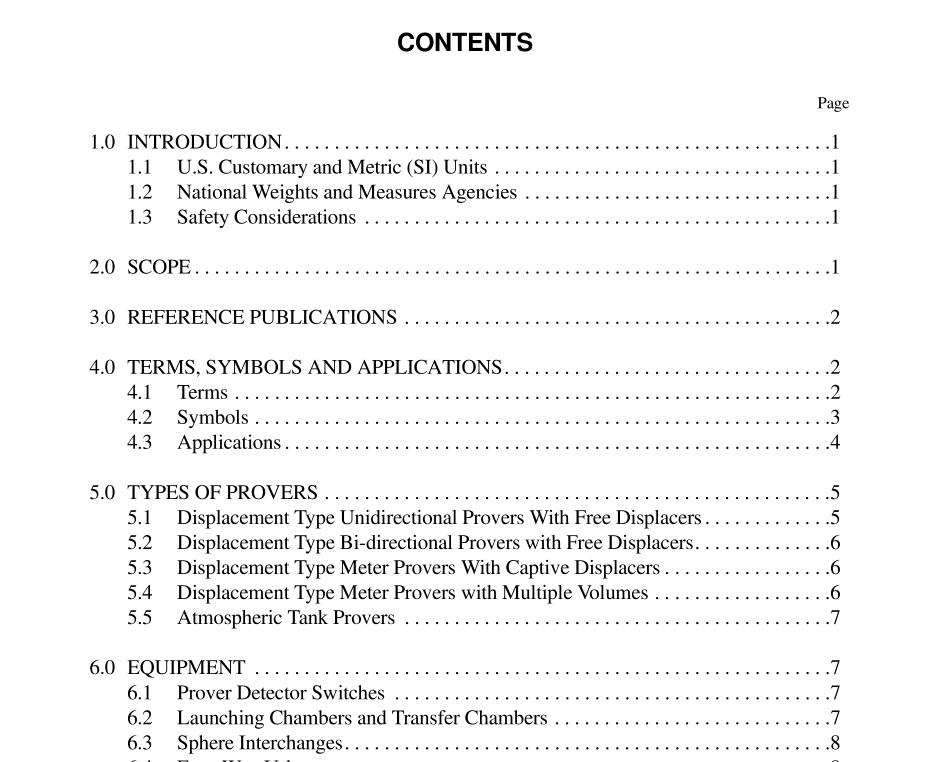API MPMS 4.9.1 pdf download

API MPMS 4.9.1 pdf download.Manual of Petroleum Measurement Standards Chapter 4—Proving Systems
2.0 Scope
Chapter 4, Section 9 covers all the procedures required to determine the field data necessary to calculate a Base Prover Volume (BPV) of either Displacement Provers or Volumetric Tank Provers. It will enable the user to perform all the activities necessary to prepare the prover, conduct calibration runs, and record all the required data necessary to calculate the base volumes of displace- ment and tank provers. Evaluation of the results and troubleshooting of many calibration problems are also discussed. This component, Chapter 4, Section 9, Part 1, is the Introduction, and contains all those relevant aspects that are general in nature, yet essential and applicable to all the different methods of calibration. Therefore, each subsequent part, which describes a specific method of prover calibration, must be used with Part 1. Together the two parts contain all the information that is essential to com- plete the required method of calibration.Detailed calculation procedures are not included in this standard. For the complete details of the calculations for each calibration method, refer to the appropriate parts of the latest edition of the API Manual of Petroleum Measurement Standards, Chapter 12, Section 2.
4.1 TERMS
4.1.1 Base Prover Volume (BPV): The volume of the prover at base conditions, as shown on the calibration certificate package, and obtained by arithmetically averaging an acceptable number of consecutive Calibrated Prover Volume (CPV) deter- minations. 4.1.2 Calibrated Prover Volume (CPV): The volume at base conditions between the detector switches of a unidirectional prover, or the volume of a prover tank between specified “empty” and “full” levels, as determined by a single calibration run. The calibrated volume of a bi-directional prover is the sum of the two volumes displaced between detectors during a calibration round-trip. 4.1.3 calibration certificate package: A document package stating the Base Prover Volume (BPV) together with the phys- ical data used to calculate the BPV. It also includes the witnessed field data, summary calculations, and the traceability documen- tation. 4.1.4 double block and bleed valve: A high-integrity valve with double seals that has provision for determining whether either seal is leaking. 4.1.5 prover calibration pass: A single movement of the displacer between two predetermined detectors. 4.1.6 prover calibration run: One pass of a unidirectional prover or one round trip of a bi-directional prover, or one empty- ing or filling of a volumetric tank prover, which provides the data which allows the calculation of a single value of the Calibrated Prover Volume (CPV).4.1.7 round trip: The combination of one OUT pass followed by one BACK pass of the displacer in a bi-directional meter prover. The OUT pass refers to the flow of the liquid in the FORWARD direction while the displacer moves away from the HOME position. The BACK pass refers to the flow of the liquid in the REVERSE direction while the displacer returns to the HOME position. The terms “Left to Right” and “Right to Left” are also used to name the pass directions. By convention, these directions are determined by facing the 4-way valve while standing near the 4-way valve but away from the prover skid. See Fig- ure 1 for an illustration of the “Left” and “Right” sides of a bi-directional meter prover. 4.1.8 targeted BPV: A term associated with atmospheric tank prover calibration, and refers to adjusting the scales to an even nominal value, such as 500 gallons or 1000 gallons. 4.1.9 traceability: The property of the result of a measurement, or the value of a standard, whereby it can be related to stated references, usually National or International Reference Standards, through an unbroken chain of comparisons all controlled, and having stated uncertainties. It should be noted that traceability only exists, when scientifically rigorous evidence is collected, on a continuing basis, showing that the measurement is producing documented results, for which the total measurement uncertainty is quantified.









